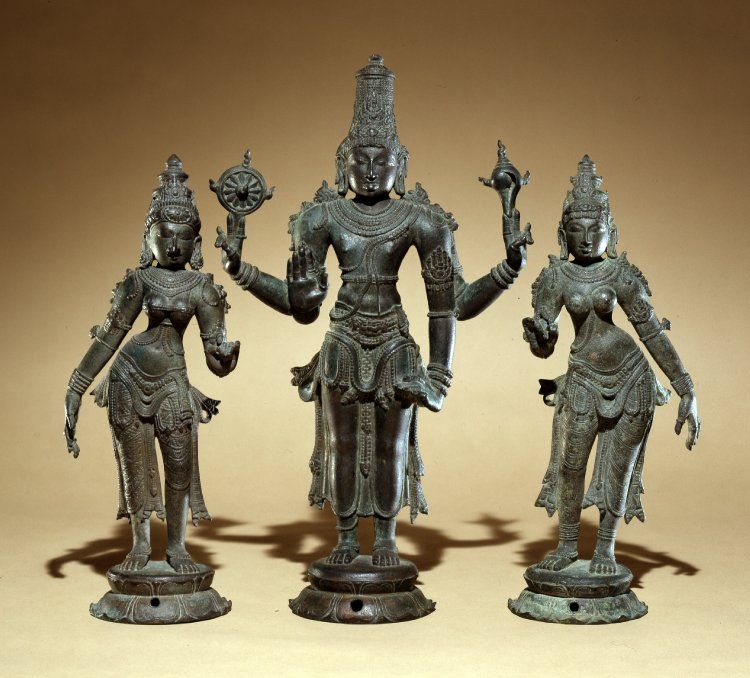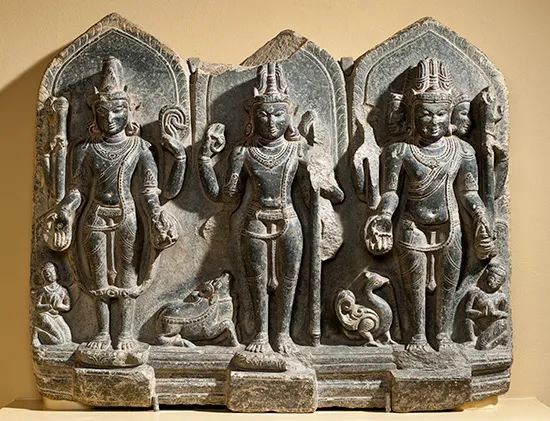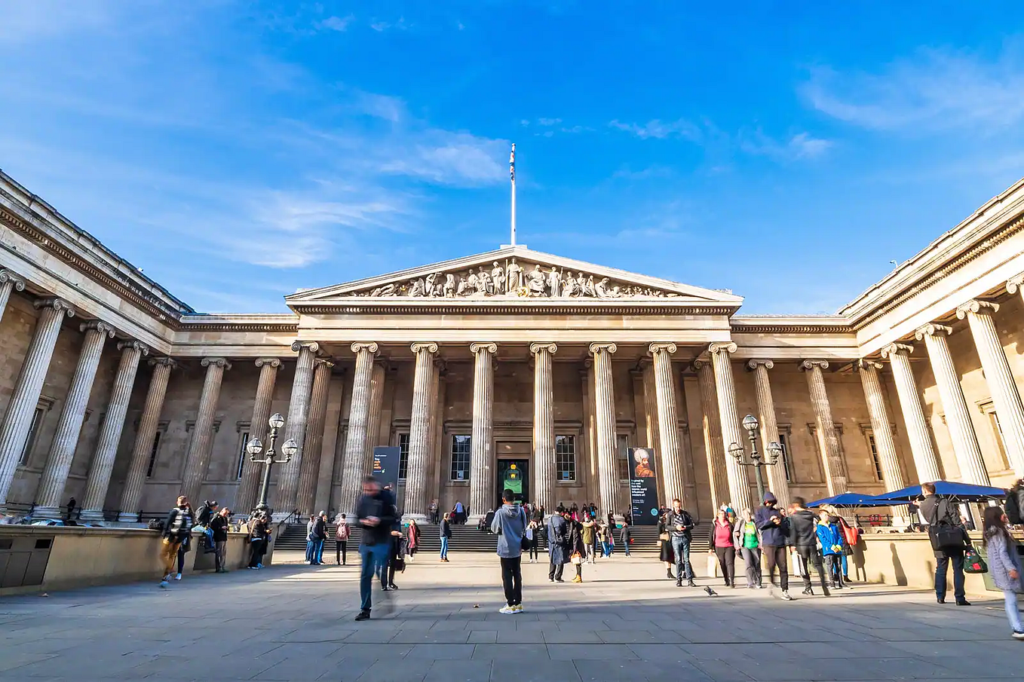The British Museum is a public museum dedicated to human history, art and culture located in the Bloomsbury area of London. Its permanent collection of eight million works is the largest in the world. It documents the story of human culture from its beginnings to the present. The British Museum was the first public national museum to cover all fields of knowledge. In this museum an idol of the sun god (Surya) carrying two ful-blown lotus blossoms has been kept. It has been mentioned against this idol that it is Made of stone (schist) , the date of Production is 13th century and Production place is Konark, Odisha. That means after the demolition of the Konark temple, the idol of Lord Sun ☀️ has been removed and finally it has been kept in British Museum. In this museum apart from the idol of lord ☀️ Sun, other idols such as Shri Jagannath with his siblings, Ganesh, Mahadev with Parvati, Durga, Hanuman, Kali , Maha Vishnu , Nataraj etc and the idols of Goutam Buddha, Mahavir have been kept. These idols have been brought from India 🇮🇳. Very interestingly in Shri Jagannath temple, Puri , Subhadra has no hands but in British museum she has two blunt hands without palm.
I have visited the British Museum, London for four times, but I never get tired of contemplating the beautiful Assyrian bulls, the Greek sculptures of the Parthenon, the idols of Hindu Gods and Goddesses, the Egyptian mummies, the statue of Ramsses II, the Rosetta Stone, the busts of Augustus, Hadrien and Antinous, the objects from the Sutton Hoo ship-burial, etc. After so many times, maybe they shouldn’t leave me breathless but they do it, even if there is a legion of tourists taking pictures, screaming at the sight of a statue and pushing in a hurry for posing in front of those objects that were once simple sheets in the text books of our childhood.
The objects tell us thousands of stories: who forged them, their models, their cities, their countries, continents, historical periods, meaning and religious or political values. Objects tell also the story of their owners for centuries. Every object is a precious witness of the ephemeral human existence.
The mummy of Cleopatra, who now reigns in the Egyptian section in the British Museum of London, is one of those immortal objects. I used to think that this mummy was the mummy of the real Cleopatra, Queen of Egypt, who committed suicide bitten by the asps. Big mistake: she’s not the Cleopatra we know from the movies though she seems to be a member of the same family who lived in II century AD.
Here you have the explanation that appears written on the pannel:

“Cleopatra: the mummy of a young woman :
The mummy and coffin of Cleopatra, daughter of Candace, from the Soter family burial, entered the British Museum in 1832 via the first collection of Henry Salt. The mummy is wrapped in many layers of cloth, with an outer shroud on which is painted a figure of the deceased woman. A comb and a necklace of beads were placed on the body inside the wooden coffin. The hieroglyphic inscription on the coffin gives Cleopatra’s age at death, for which a reading of 17 years, 1 month and 25 days has been proposed. X-ray studies using a CAT scanner show a skeletal development and a fusion of the ends of the long bones which is consistent with this age.
The skeleton appears to be in good conditions. The skull is tilted forward and the mouth is open. There are at least three packages in the right chest cavity, possibly the preserved internal organs. An object, about 9cm long, in the left chest cavity may be a roll of linen or a figurine. CAT scans also revealed the use of packing materials (probably mud or sand), which contribute to the substantial weight (about 75kg) of this mummy”.
There is also an interesting story related to the discovery of the Mummy, as it’s always the case when the protagonists are Lords or British adventurers in Greece, Turkey, Egypt… Some speak of plundering of national treasures, and others (the explorers, archaeologists or simply rich people) talk about recovery of abandoned or severely neglected pieces that they brought to England for the future of the human being.
After seeing the idols of Hindu gods and goddesses and idols of Egyptian gods and goddesses in British museum, I have made a study and came to know the following:
Ancient Egypt, a civilization that’s always been of fascination and mystery to me, taps deeply into the idea of an after life. The idea is that there are two parts of us. One that makes us, us, and another part of us that is more than just a body. left an indelible mark on history with its rich cultural and religious practices. The concept of Ka and Ba are integral components of the ancient Egyptians’ intricate understanding of the soul and the afterlife. In this exploration, we delve into the depths of these spiritual elements crucial in shaping the Egyptians’ perception of existence beyond the mortal realm.
Duality of the soul!: Central to the ancient Egyptian belief system was the idea that each person possessed not one but multiple components of the soul. The Ka and Ba represented two different yet interconnected aspects of the individual, like spaghetti and meatballs.

Ka aka “The Life Force”: The Ka was considered an individual’s life force or vital essence. It was believed to be an integral part of a person’s identity, representing the energy that makes us distinct. The Ka was associated with sustenance and prosperity during one’s earthly life, and it was thought to reside within the body. The concept of Ka emphasized the importance of maintaining the body through rituals, proper burial practices, and offerings. The Egyptians believed that a well-preserved body would ensure the continued existence of the Ka in the afterlife, allowing the deceased to draw sustenance from the offerings left at their tomb.
Ba aka Personality or Soul: The Ba was the second part of the soul and represented the individual’s personality, consciousness, and unique characteristics. So, my “Ba” is what makes me weird, It was often depicted as a bird with human features and was believed to be able to move freely between the earthly and afterlife realms. In other words, this is the part of you that leaves these meat bags and continues on to other unworldly places?
The relationship between the Ka and Ba was symbiotic, reflecting the interconnected nature of Egyptian beliefs about life and death. While the Ka required a well-preserved body for its continued existence in the afterlife, the Ba needed to reunite with the Ka to achieve a harmonious and eternal existence.
The Egyptians’ meticulous attention to funerary rituals and burial practices stemmed from their profound understanding of the Ka and Ba. Mummification, tomb construction, and the elaborate ceremonies surrounding death were all aimed at preserving the body and ensuring a smooth journey for the Ba through the afterlife.
The concept of Ka and Ba offers a captivating glimpse into the spiritual beliefs that shaped the worldview of ancient Egyptians. And, today in 2024 makes me very interested. With this belief, it apparently wasn’t just about understanding life and death but to better understand how we navigate this afterlife. It is quite amazing to me the connection this culture has as it relates to our life here on earth and how it connects to what happens after we die. All this does is make my imagination run wild. How did they come to believe in this? Whatever evidence or experiences did the natives have that lead to such a belief that there is something that happens after we die?
Hindu and Egyptian gods have a lot in common, even though they come from places as far apart as the Indus Valley and the Nile River. These gods often have similar roles and symbols, which shows that people all over the world have common ideas when it comes to creation and protecting themselves.
In both Hindu and Egyptian cultures, powerful symbols are important because they represent the idea of protection and strength.
For example, in Hinduism, Lord Shiva holds a trident called the Trishula. This isn’t just for show – it’s a sign that he’s in charge of keeping balance in the universe and fighting off bad forces.
In ancient Egypt, the Eye of Horus is another strong symbol. It’s not just a cool design; it’s meant to heal and protect people, and Egyptians would wear it like a lucky charm to keep away harm.
These symbols do more than just look nice – they show that people have always looked to something greater than themselves for safety and control. It’s a common thing across different cultures to want to feel protected by a higher power.
Hindu and Egyptian cultures have their own unique ways of honoring their gods. In Hinduism, people perform puja, which is a way to show respect to their gods by giving them gifts like flowers, nice smells from incense, and food. They also say special chants and read from holy books. In the old days of Egypt, people did something similar. They gave food and other items to their gods, and they sang hymns and said prayers.

These rituals are important because they help people feel closer to the spiritual world. Both Hindus and Egyptians would make sure they and the places where they worshiped were clean and pure before starting their rituals. This shows us that people all around the world have a natural desire to connect with something bigger than themselves through acts of worship.
When we talk about these practices, it’s like we can see a common thread across different cultures. They all have ways to show their gods love and respect, hoping that the gods will look favorably upon them in return. This back-and-forth with the divine is a key part of being human and trying to understand our place in the universe.
In conversation, you might say that both Hindus and ancient Egyptians went to great lengths to make sure their gods were happy. They believed that by taking care of their gods, the gods would take care of them. It’s like when you recommend a product to a friend because you’ve tried it and you know it’s good. You’re sharing something valuable, hoping it will benefit them, too. That’s the kind of relationship people in these cultures wanted with their gods.
In life, Hindus and Egyptians used rituals to feel close to godly forces. After death, their beliefs still focus deeply on what happens with our spirits.
Hindus think life, death, and being born again keep repeating in a cycle known as samsara, which the good or bad deeds, called karma, can influence. They aim for moksha, which means breaking free from this cycle.
On the other hand, Egyptians thought that after death, people go on a straight path to a place called the Hall of Maat to be judged. They believed that if a person’s heart was as light as the feather of Maat—a symbol of truth and justice—they could get into the forever happy Field of Reeds.
Both views make it clear that our actions have moral weight and decide what happens to us after we die. They also have detailed beliefs about the journey after death.
Let’s make this simpler to understand. Like how a good GPS ensures you don’t get lost on a road trip, these beliefs are like spiritual maps that guide people on what they think happens after our last breath.
Hindus aim for moksha, kind of like a final exit from the highway of life and death. Egyptians, meanwhile, viewed the afterlife as a one-way ticket to an eternal paradise, but only if you’ve led a good life. It’s like getting through a VIP entrance, but the bouncer is a feather.
Both cultures teach that living a good, moral life is crucial because it could affect our ultimate destiny. This shows how seriously they took the idea of life after death, almost like reading a detailed user manual before using a complex gadget. It’s all about making sure we understand the rules of the game before we play it.
In short, when we look closely at the gods of Hinduism and ancient Egypt, we find that they have a lot in common, especially when it comes to the stories about how the world began, what gods represent, and how people worshipped them. These similarities show us that no matter where we are from, humans often think in similar ways about gods, life after death, and the rules that they believe govern the world. By studying these ancient religions side by side, we can better understand how old beliefs still shape what many people think today.
For example, both Hindu and Egyptian cultures have a god of the sun—Surya in Hinduism and Ra in ancient Egypt. They both ride across the sky, showing how people from different places can have the same kind of idea about how nature works. Also, rituals like prayer and offerings were common in both religions, which shows that humans have always tried to connect with something bigger than themselves.
Using clear words and everyday language makes it easier to see why these connections between old religions matter. It helps us to appreciate the rich details of these beliefs and how they continue to influence modern thoughts on spirituality and religion.

